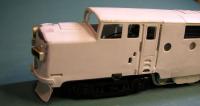 |
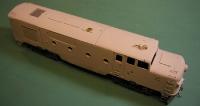 |
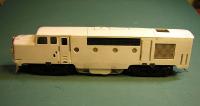 |
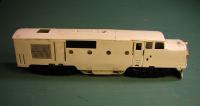 |
 |
 |
 |
 |
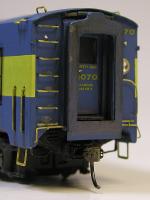 |
|
 |
 |
The Prototype:
Built by ALCO in February of 1943
Builders #70668 was delivered as US Army #8047 RSD1 with three axle trucks.
This locomotive was acquired by the Alaska Railroad in December 1949 to
be rostered as ARR #1022. Rebuilt in January 1950 by PSB&D
into RF1A with two axle B-B trucks. Retired in her original blue
and yellow paint as of April 1970 and finally scrapped in late 1973.
In 1947 the Alaska Railroad began a rebuild program to enclose the car bodies on ALCO road switchers to create streamlined locomotives for the Aurora passenger trains. The effort resulted in 1050A and 1051B units that could only be kindly described as extremely homely.
Lessons were learned and orders were given to Puget Sound Bridge and Dry Dock Co. of Seattle to convert 7 additional RSD1 units into shrouded A units with somewhat better lines to become ARR class RF1. These were all built during 1949-50 and during the process converted to two axle B-B trucks. The RF1A units received even numbers: 1052, 1554, 1070, 1072, 1074, 1076, 1078 with no explanation why the numbers were not sequential.
A total of eight B units were built with some conjecture about where. Some were built in the Anchorage shops, and some may have been built by PSB&D but the records were lost in the 1951 Anchorage shop fire. RF1B units received odd numbers: 1053, 1055, 1057, 1065, 1067, 1069, 1075 and 1077 again with no rational for the nonsequential numbers.
The conversion actually resulted
in a loss of 300 pounds for a service weight of 253,700 pounds and retained
the 75:16 double reduction gears. The first unit was scrapped in
1963 and they were all gone to scrap by late 1973.
The Model:
RF1A #1070 was chosen to model
as it was the last unit retired still in the blue and yellow paint job.
A units #1072, 1078 and B unit 1065 survived in black and yellow paint
as power for the rotary snow plow until the summer of 1972.
In EXTRA 2200 SOUTH Issue 58 of 1976, on page 20 there is a single right side elevation drawing of RF1A #1078. This drawing is not in scale but with proportional dividers, photos and a digitized copy of this source drawing I was able to create a usable set of drawings for modeling purposes. Thanks to John's Alaska Railroad Pages, a variety of roster shots have come to light during 2000. The excellent photos provided from Jack Klingbiel's collection and some rare shots from John Henderson filled in the details needed to attempt a credible model.
#1070 survived long enough that it had to comply with FRA rules calling for the hand grab irons up the nose to allow for window cleaning and service to the sand hatches. You will note that these grabs extend out further from the body than the original appliances. Since the car body sheeting was applied outside the original walkway of the RS1 road switcher, they began to push width restrictions. To compensate the original grab irons and handrails were set back into a curved clearance notch fabricated "C" into the car body side. Evidently clearance was not a concern when the extra grabs were added later.
Not having an RSD1 to start from, I chose the Atlas RS1 which provided the proper frame length over buffers, proper trucks and truck centers and an excellent mechanism. The step wells and the fuel tanks and battery boxes were milled off. The frame was cut back on the short hood end and replaced with an ALCO PA snow plow pilot with some heavy modifications. The side radiator shutters were cut out and used in the finished model. That is just how PSB&D did the big ones.
The car body was formed up over a bi-level passenger car roof/window insert using multiple layers of styrene in the kit bashing process. Many photos were taken along the way. A parts list, copy of the drawing in HO scale showing the general layout of all locomotive features, and some pointers are available on request. If there is interest expressed we can offer these up via John's Alaska RailRoad Page as a construction article.
Bob Barrett of Sterling, Ak provided the nose herald and decals which were originally done for the ARR F7 1500 class locos. These required modification but the color is consistent because all of the yellow is decal film except for hand rails and touch up which are done with PolyS Railbox Yellow. The weathered blue is GTW blue with 20% SP Lettering Gray.
The locomotive will be finished with a Soundtrax early ALCO sound system for engine horn, bell and three light functions. There is room for a big speaker under the rear radiator vent. Eventually she will be kept company by RF1B #1065 in the Black and Yellow paint scheme.
Happy modeling. For all of
those waiting on custom paint jobs, this is what caused the delay.
Sorry, but when the mood strikes it must be followed.
You'll find a photo of the prototype
here.